Essay: PHC Service Delivery for Older Adults in Australia
VerifiedAdded on 2023/01/13
|9
|2551
|71
Essay
AI Summary
This essay provides a critical analysis of Primary Health Care (PHC) service delivery for older adults in Australia, emphasizing its significance given the aging population. It explores the scope of PHC services, including promotive, preventive, curative, rehabilitative, and supportive care within the community setting. The essay evaluates resource allocation, highlighting the roles of various healthcare professionals and the importance of healthy aging. It also addresses the strengths of PHC in early disease detection and management, while acknowledging limitations such as poor system integration, limited access, and a lack of culturally competent healthcare workers, particularly in rural areas. The essay further discusses the role of PHC in mental health management, including screening for psychological distress and early signs of dementia. Finally, it concludes by acknowledging government initiatives to improve PHC services and funding for older adults' mental health needs, aiming to enhance the overall quality of aged care in Australia.
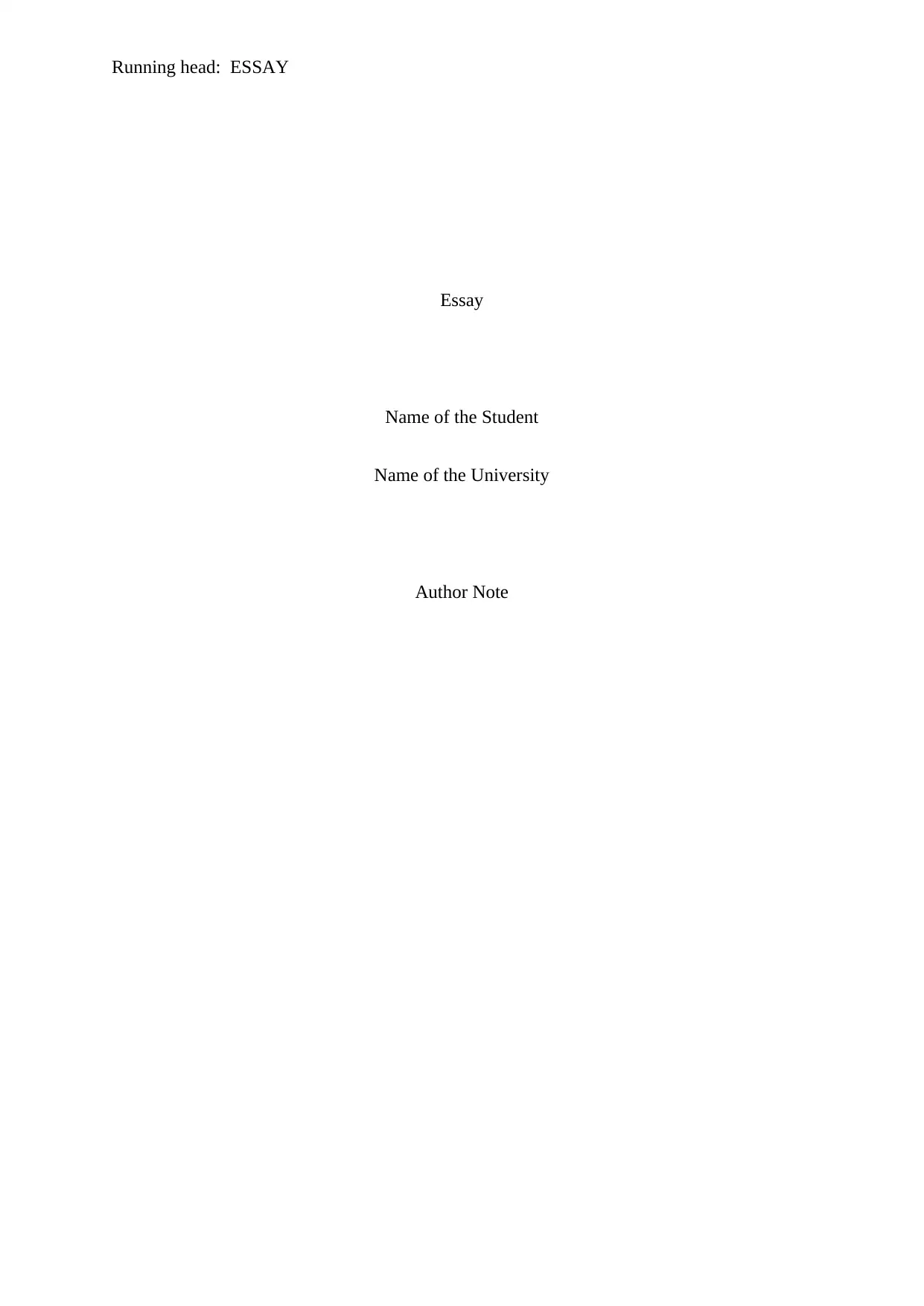
Running head: ESSAY
Essay
Name of the Student
Name of the University
Author Note
Essay
Name of the Student
Name of the University
Author Note
Paraphrase This Document
Need a fresh take? Get an instant paraphrase of this document with our AI Paraphraser
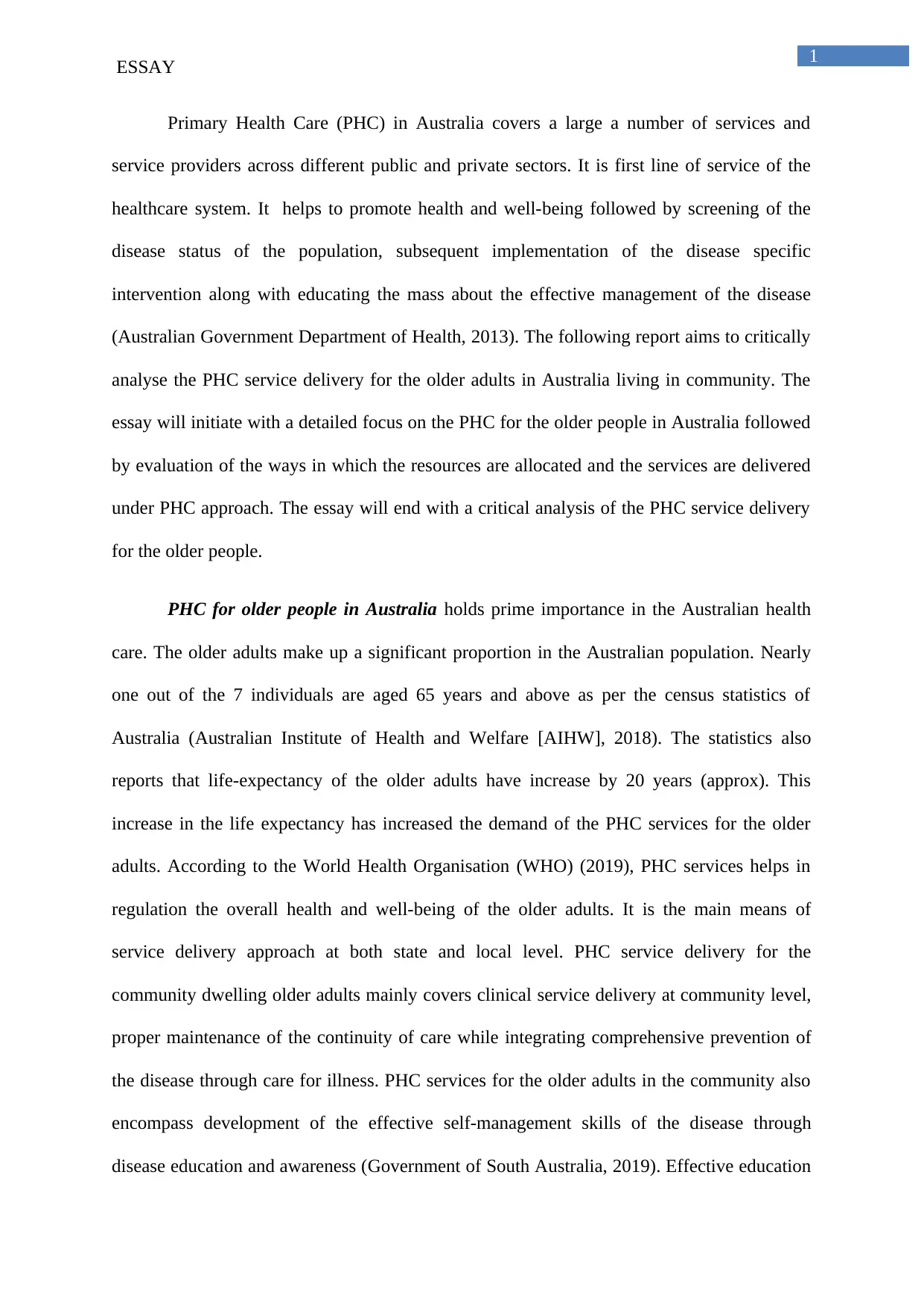
1
ESSAY
Primary Health Care (PHC) in Australia covers a large a number of services and
service providers across different public and private sectors. It is first line of service of the
healthcare system. It helps to promote health and well-being followed by screening of the
disease status of the population, subsequent implementation of the disease specific
intervention along with educating the mass about the effective management of the disease
(Australian Government Department of Health, 2013). The following report aims to critically
analyse the PHC service delivery for the older adults in Australia living in community. The
essay will initiate with a detailed focus on the PHC for the older people in Australia followed
by evaluation of the ways in which the resources are allocated and the services are delivered
under PHC approach. The essay will end with a critical analysis of the PHC service delivery
for the older people.
PHC for older people in Australia holds prime importance in the Australian health
care. The older adults make up a significant proportion in the Australian population. Nearly
one out of the 7 individuals are aged 65 years and above as per the census statistics of
Australia (Australian Institute of Health and Welfare [AIHW], 2018). The statistics also
reports that life-expectancy of the older adults have increase by 20 years (approx). This
increase in the life expectancy has increased the demand of the PHC services for the older
adults. According to the World Health Organisation (WHO) (2019), PHC services helps in
regulation the overall health and well-being of the older adults. It is the main means of
service delivery approach at both state and local level. PHC service delivery for the
community dwelling older adults mainly covers clinical service delivery at community level,
proper maintenance of the continuity of care while integrating comprehensive prevention of
the disease through care for illness. PHC services for the older adults in the community also
encompass development of the effective self-management skills of the disease through
disease education and awareness (Government of South Australia, 2019). Effective education
ESSAY
Primary Health Care (PHC) in Australia covers a large a number of services and
service providers across different public and private sectors. It is first line of service of the
healthcare system. It helps to promote health and well-being followed by screening of the
disease status of the population, subsequent implementation of the disease specific
intervention along with educating the mass about the effective management of the disease
(Australian Government Department of Health, 2013). The following report aims to critically
analyse the PHC service delivery for the older adults in Australia living in community. The
essay will initiate with a detailed focus on the PHC for the older people in Australia followed
by evaluation of the ways in which the resources are allocated and the services are delivered
under PHC approach. The essay will end with a critical analysis of the PHC service delivery
for the older people.
PHC for older people in Australia holds prime importance in the Australian health
care. The older adults make up a significant proportion in the Australian population. Nearly
one out of the 7 individuals are aged 65 years and above as per the census statistics of
Australia (Australian Institute of Health and Welfare [AIHW], 2018). The statistics also
reports that life-expectancy of the older adults have increase by 20 years (approx). This
increase in the life expectancy has increased the demand of the PHC services for the older
adults. According to the World Health Organisation (WHO) (2019), PHC services helps in
regulation the overall health and well-being of the older adults. It is the main means of
service delivery approach at both state and local level. PHC service delivery for the
community dwelling older adults mainly covers clinical service delivery at community level,
proper maintenance of the continuity of care while integrating comprehensive prevention of
the disease through care for illness. PHC services for the older adults in the community also
encompass development of the effective self-management skills of the disease through
disease education and awareness (Government of South Australia, 2019). Effective education
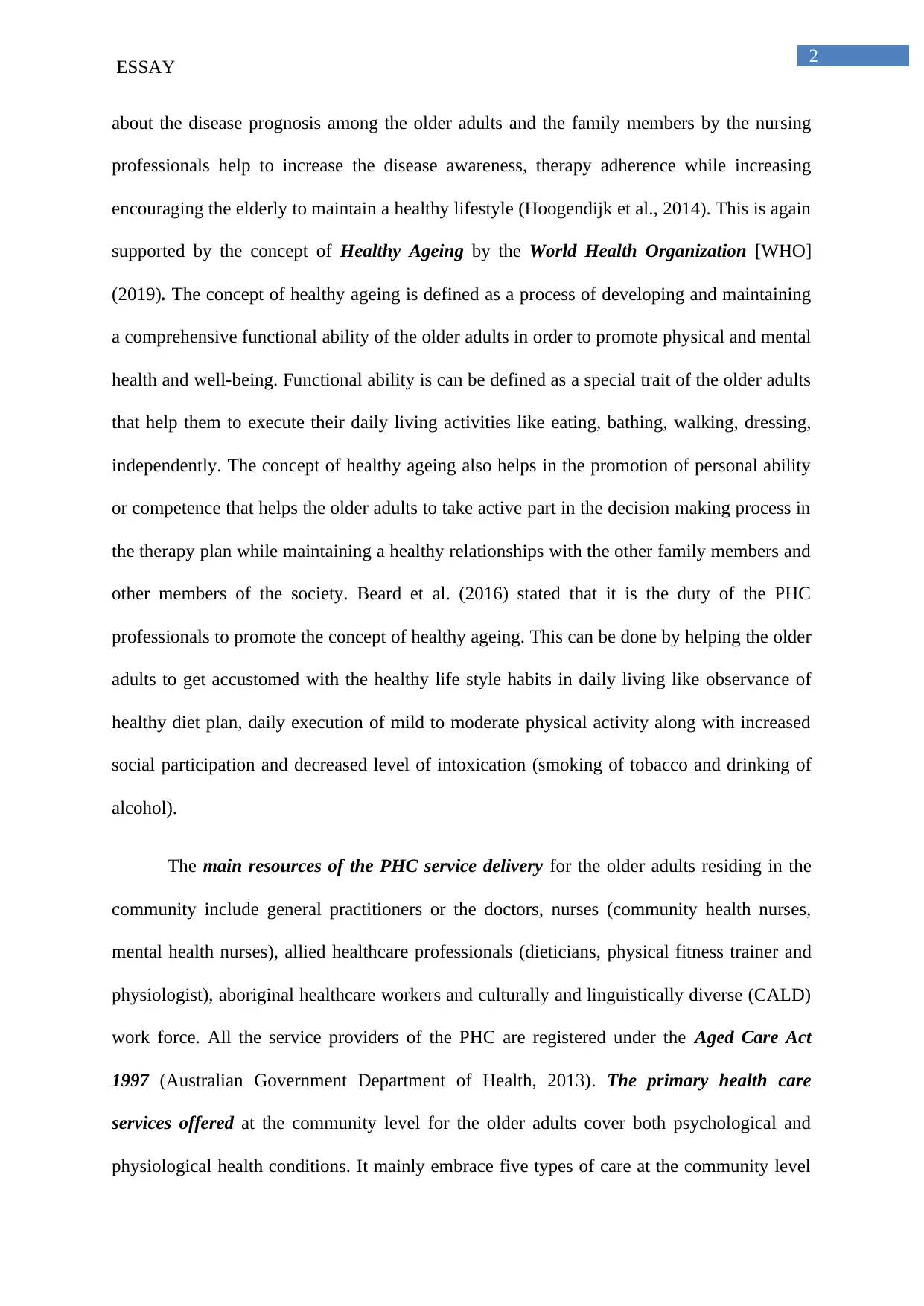
2
ESSAY
about the disease prognosis among the older adults and the family members by the nursing
professionals help to increase the disease awareness, therapy adherence while increasing
encouraging the elderly to maintain a healthy lifestyle (Hoogendijk et al., 2014). This is again
supported by the concept of Healthy Ageing by the World Health Organization [WHO]
(2019). The concept of healthy ageing is defined as a process of developing and maintaining
a comprehensive functional ability of the older adults in order to promote physical and mental
health and well-being. Functional ability is can be defined as a special trait of the older adults
that help them to execute their daily living activities like eating, bathing, walking, dressing,
independently. The concept of healthy ageing also helps in the promotion of personal ability
or competence that helps the older adults to take active part in the decision making process in
the therapy plan while maintaining a healthy relationships with the other family members and
other members of the society. Beard et al. (2016) stated that it is the duty of the PHC
professionals to promote the concept of healthy ageing. This can be done by helping the older
adults to get accustomed with the healthy life style habits in daily living like observance of
healthy diet plan, daily execution of mild to moderate physical activity along with increased
social participation and decreased level of intoxication (smoking of tobacco and drinking of
alcohol).
The main resources of the PHC service delivery for the older adults residing in the
community include general practitioners or the doctors, nurses (community health nurses,
mental health nurses), allied healthcare professionals (dieticians, physical fitness trainer and
physiologist), aboriginal healthcare workers and culturally and linguistically diverse (CALD)
work force. All the service providers of the PHC are registered under the Aged Care Act
1997 (Australian Government Department of Health, 2013). The primary health care
services offered at the community level for the older adults cover both psychological and
physiological health conditions. It mainly embrace five types of care at the community level
ESSAY
about the disease prognosis among the older adults and the family members by the nursing
professionals help to increase the disease awareness, therapy adherence while increasing
encouraging the elderly to maintain a healthy lifestyle (Hoogendijk et al., 2014). This is again
supported by the concept of Healthy Ageing by the World Health Organization [WHO]
(2019). The concept of healthy ageing is defined as a process of developing and maintaining
a comprehensive functional ability of the older adults in order to promote physical and mental
health and well-being. Functional ability is can be defined as a special trait of the older adults
that help them to execute their daily living activities like eating, bathing, walking, dressing,
independently. The concept of healthy ageing also helps in the promotion of personal ability
or competence that helps the older adults to take active part in the decision making process in
the therapy plan while maintaining a healthy relationships with the other family members and
other members of the society. Beard et al. (2016) stated that it is the duty of the PHC
professionals to promote the concept of healthy ageing. This can be done by helping the older
adults to get accustomed with the healthy life style habits in daily living like observance of
healthy diet plan, daily execution of mild to moderate physical activity along with increased
social participation and decreased level of intoxication (smoking of tobacco and drinking of
alcohol).
The main resources of the PHC service delivery for the older adults residing in the
community include general practitioners or the doctors, nurses (community health nurses,
mental health nurses), allied healthcare professionals (dieticians, physical fitness trainer and
physiologist), aboriginal healthcare workers and culturally and linguistically diverse (CALD)
work force. All the service providers of the PHC are registered under the Aged Care Act
1997 (Australian Government Department of Health, 2013). The primary health care
services offered at the community level for the older adults cover both psychological and
physiological health conditions. It mainly embrace five types of care at the community level
⊘ This is a preview!⊘
Do you want full access?
Subscribe today to unlock all pages.

Trusted by 1+ million students worldwide
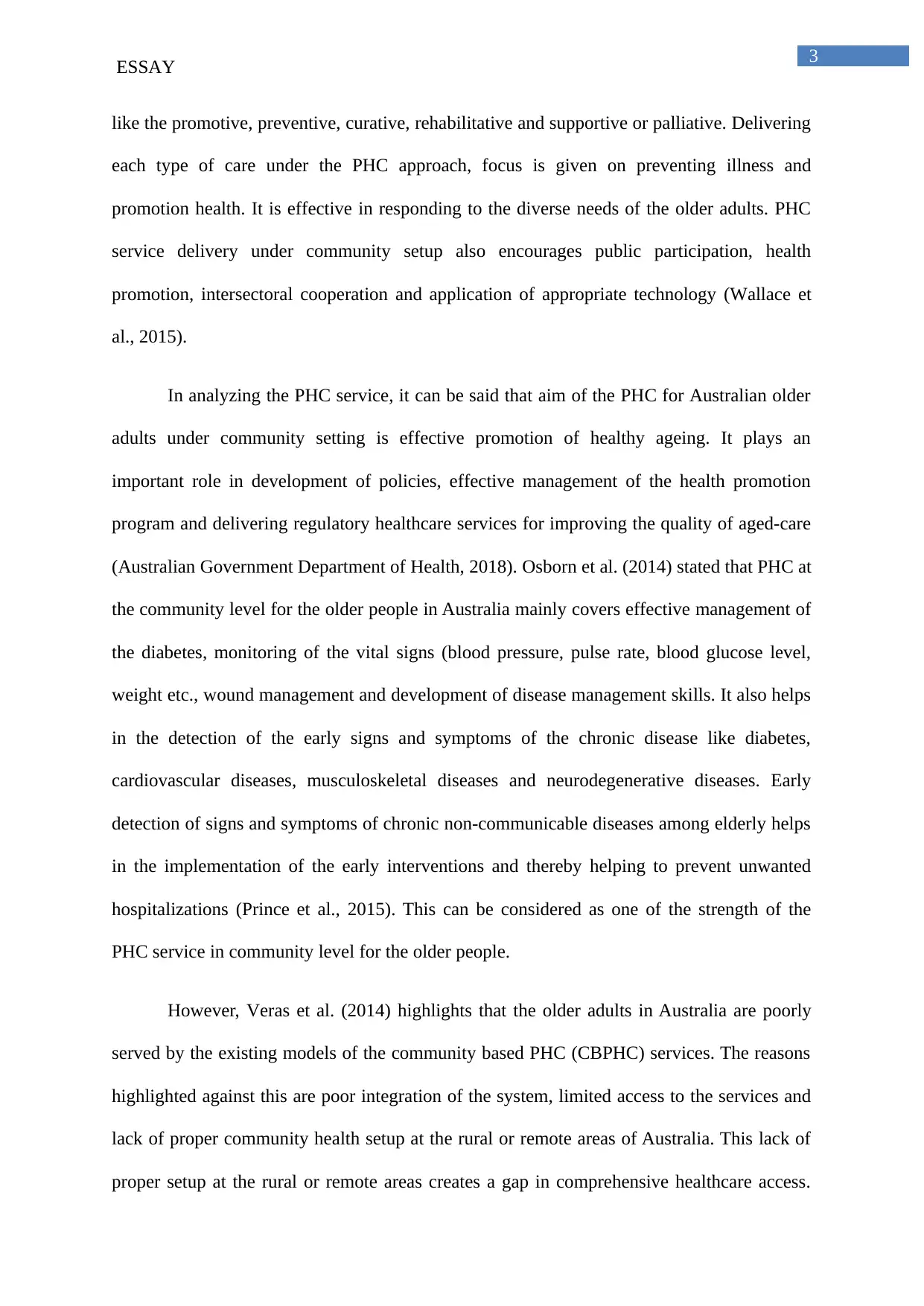
3
ESSAY
like the promotive, preventive, curative, rehabilitative and supportive or palliative. Delivering
each type of care under the PHC approach, focus is given on preventing illness and
promotion health. It is effective in responding to the diverse needs of the older adults. PHC
service delivery under community setup also encourages public participation, health
promotion, intersectoral cooperation and application of appropriate technology (Wallace et
al., 2015).
In analyzing the PHC service, it can be said that aim of the PHC for Australian older
adults under community setting is effective promotion of healthy ageing. It plays an
important role in development of policies, effective management of the health promotion
program and delivering regulatory healthcare services for improving the quality of aged-care
(Australian Government Department of Health, 2018). Osborn et al. (2014) stated that PHC at
the community level for the older people in Australia mainly covers effective management of
the diabetes, monitoring of the vital signs (blood pressure, pulse rate, blood glucose level,
weight etc., wound management and development of disease management skills. It also helps
in the detection of the early signs and symptoms of the chronic disease like diabetes,
cardiovascular diseases, musculoskeletal diseases and neurodegenerative diseases. Early
detection of signs and symptoms of chronic non-communicable diseases among elderly helps
in the implementation of the early interventions and thereby helping to prevent unwanted
hospitalizations (Prince et al., 2015). This can be considered as one of the strength of the
PHC service in community level for the older people.
However, Veras et al. (2014) highlights that the older adults in Australia are poorly
served by the existing models of the community based PHC (CBPHC) services. The reasons
highlighted against this are poor integration of the system, limited access to the services and
lack of proper community health setup at the rural or remote areas of Australia. This lack of
proper setup at the rural or remote areas creates a gap in comprehensive healthcare access.
ESSAY
like the promotive, preventive, curative, rehabilitative and supportive or palliative. Delivering
each type of care under the PHC approach, focus is given on preventing illness and
promotion health. It is effective in responding to the diverse needs of the older adults. PHC
service delivery under community setup also encourages public participation, health
promotion, intersectoral cooperation and application of appropriate technology (Wallace et
al., 2015).
In analyzing the PHC service, it can be said that aim of the PHC for Australian older
adults under community setting is effective promotion of healthy ageing. It plays an
important role in development of policies, effective management of the health promotion
program and delivering regulatory healthcare services for improving the quality of aged-care
(Australian Government Department of Health, 2018). Osborn et al. (2014) stated that PHC at
the community level for the older people in Australia mainly covers effective management of
the diabetes, monitoring of the vital signs (blood pressure, pulse rate, blood glucose level,
weight etc., wound management and development of disease management skills. It also helps
in the detection of the early signs and symptoms of the chronic disease like diabetes,
cardiovascular diseases, musculoskeletal diseases and neurodegenerative diseases. Early
detection of signs and symptoms of chronic non-communicable diseases among elderly helps
in the implementation of the early interventions and thereby helping to prevent unwanted
hospitalizations (Prince et al., 2015). This can be considered as one of the strength of the
PHC service in community level for the older people.
However, Veras et al. (2014) highlights that the older adults in Australia are poorly
served by the existing models of the community based PHC (CBPHC) services. The reasons
highlighted against this are poor integration of the system, limited access to the services and
lack of proper community health setup at the rural or remote areas of Australia. This lack of
proper setup at the rural or remote areas creates a gap in comprehensive healthcare access.
Paraphrase This Document
Need a fresh take? Get an instant paraphrase of this document with our AI Paraphraser
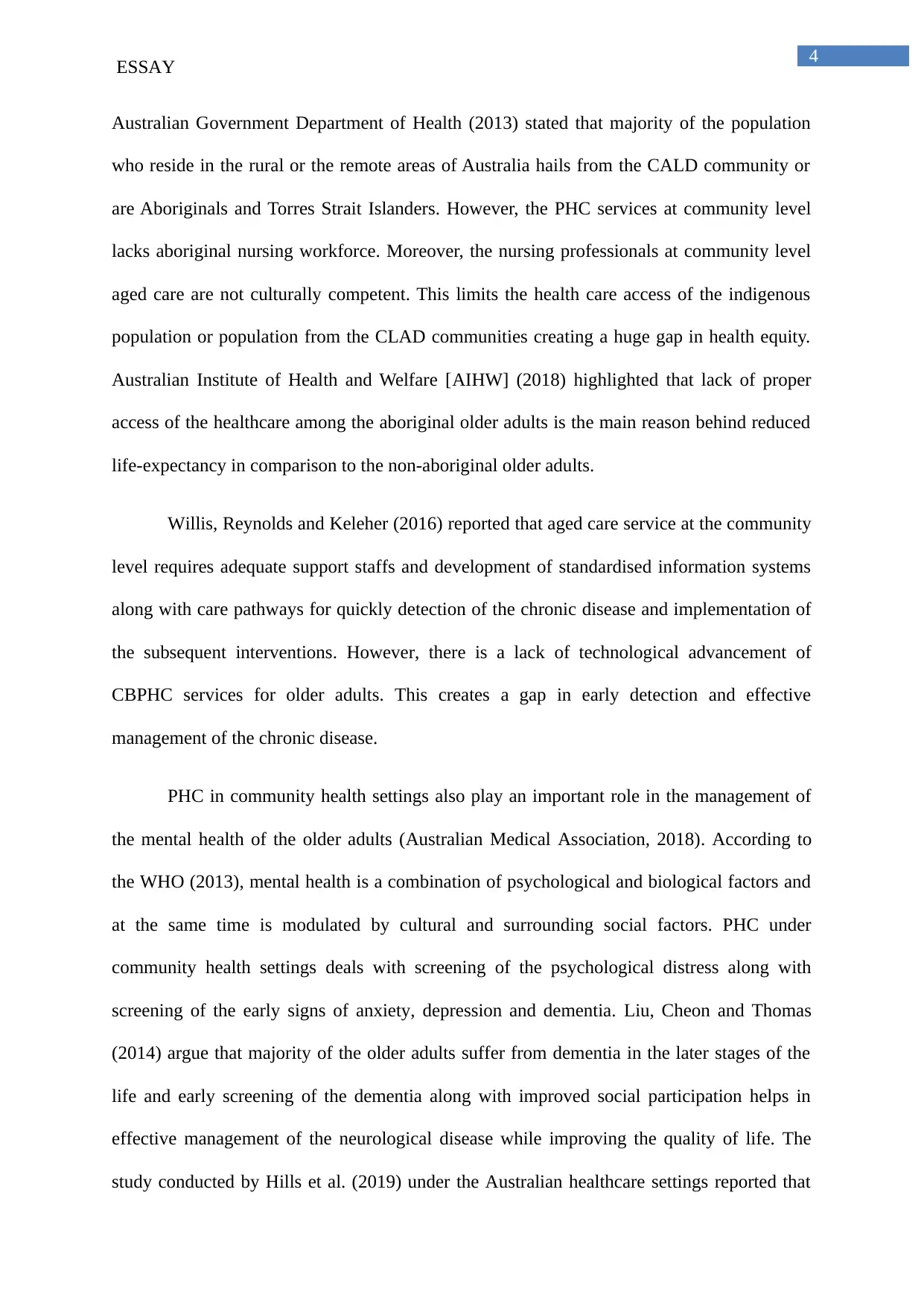
4
ESSAY
Australian Government Department of Health (2013) stated that majority of the population
who reside in the rural or the remote areas of Australia hails from the CALD community or
are Aboriginals and Torres Strait Islanders. However, the PHC services at community level
lacks aboriginal nursing workforce. Moreover, the nursing professionals at community level
aged care are not culturally competent. This limits the health care access of the indigenous
population or population from the CLAD communities creating a huge gap in health equity.
Australian Institute of Health and Welfare [AIHW] (2018) highlighted that lack of proper
access of the healthcare among the aboriginal older adults is the main reason behind reduced
life-expectancy in comparison to the non-aboriginal older adults.
Willis, Reynolds and Keleher (2016) reported that aged care service at the community
level requires adequate support staffs and development of standardised information systems
along with care pathways for quickly detection of the chronic disease and implementation of
the subsequent interventions. However, there is a lack of technological advancement of
CBPHC services for older adults. This creates a gap in early detection and effective
management of the chronic disease.
PHC in community health settings also play an important role in the management of
the mental health of the older adults (Australian Medical Association, 2018). According to
the WHO (2013), mental health is a combination of psychological and biological factors and
at the same time is modulated by cultural and surrounding social factors. PHC under
community health settings deals with screening of the psychological distress along with
screening of the early signs of anxiety, depression and dementia. Liu, Cheon and Thomas
(2014) argue that majority of the older adults suffer from dementia in the later stages of the
life and early screening of the dementia along with improved social participation helps in
effective management of the neurological disease while improving the quality of life. The
study conducted by Hills et al. (2019) under the Australian healthcare settings reported that
ESSAY
Australian Government Department of Health (2013) stated that majority of the population
who reside in the rural or the remote areas of Australia hails from the CALD community or
are Aboriginals and Torres Strait Islanders. However, the PHC services at community level
lacks aboriginal nursing workforce. Moreover, the nursing professionals at community level
aged care are not culturally competent. This limits the health care access of the indigenous
population or population from the CLAD communities creating a huge gap in health equity.
Australian Institute of Health and Welfare [AIHW] (2018) highlighted that lack of proper
access of the healthcare among the aboriginal older adults is the main reason behind reduced
life-expectancy in comparison to the non-aboriginal older adults.
Willis, Reynolds and Keleher (2016) reported that aged care service at the community
level requires adequate support staffs and development of standardised information systems
along with care pathways for quickly detection of the chronic disease and implementation of
the subsequent interventions. However, there is a lack of technological advancement of
CBPHC services for older adults. This creates a gap in early detection and effective
management of the chronic disease.
PHC in community health settings also play an important role in the management of
the mental health of the older adults (Australian Medical Association, 2018). According to
the WHO (2013), mental health is a combination of psychological and biological factors and
at the same time is modulated by cultural and surrounding social factors. PHC under
community health settings deals with screening of the psychological distress along with
screening of the early signs of anxiety, depression and dementia. Liu, Cheon and Thomas
(2014) argue that majority of the older adults suffer from dementia in the later stages of the
life and early screening of the dementia along with improved social participation helps in
effective management of the neurological disease while improving the quality of life. The
study conducted by Hills et al. (2019) under the Australian healthcare settings reported that
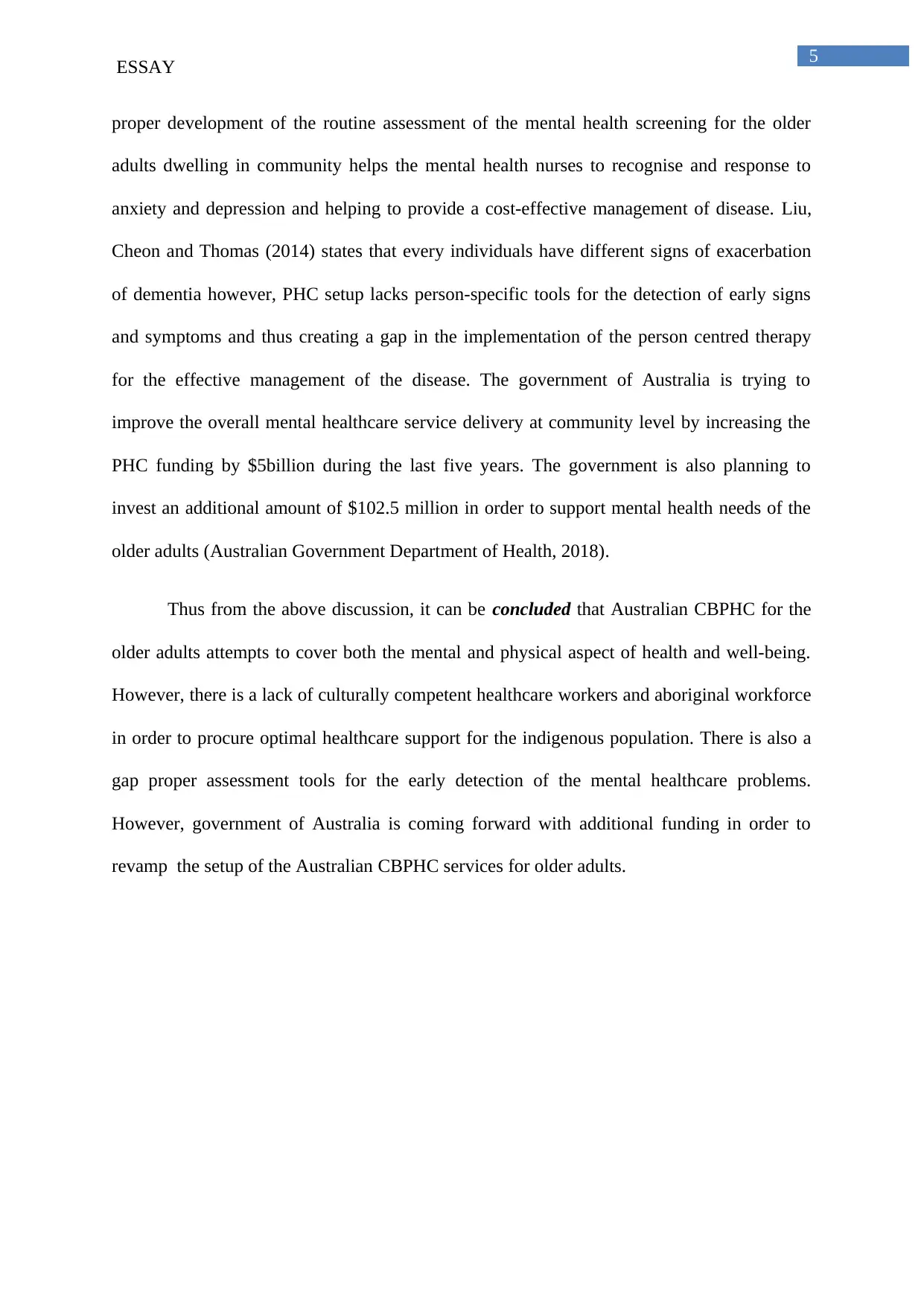
5
ESSAY
proper development of the routine assessment of the mental health screening for the older
adults dwelling in community helps the mental health nurses to recognise and response to
anxiety and depression and helping to provide a cost-effective management of disease. Liu,
Cheon and Thomas (2014) states that every individuals have different signs of exacerbation
of dementia however, PHC setup lacks person-specific tools for the detection of early signs
and symptoms and thus creating a gap in the implementation of the person centred therapy
for the effective management of the disease. The government of Australia is trying to
improve the overall mental healthcare service delivery at community level by increasing the
PHC funding by $5billion during the last five years. The government is also planning to
invest an additional amount of $102.5 million in order to support mental health needs of the
older adults (Australian Government Department of Health, 2018).
Thus from the above discussion, it can be concluded that Australian CBPHC for the
older adults attempts to cover both the mental and physical aspect of health and well-being.
However, there is a lack of culturally competent healthcare workers and aboriginal workforce
in order to procure optimal healthcare support for the indigenous population. There is also a
gap proper assessment tools for the early detection of the mental healthcare problems.
However, government of Australia is coming forward with additional funding in order to
revamp the setup of the Australian CBPHC services for older adults.
ESSAY
proper development of the routine assessment of the mental health screening for the older
adults dwelling in community helps the mental health nurses to recognise and response to
anxiety and depression and helping to provide a cost-effective management of disease. Liu,
Cheon and Thomas (2014) states that every individuals have different signs of exacerbation
of dementia however, PHC setup lacks person-specific tools for the detection of early signs
and symptoms and thus creating a gap in the implementation of the person centred therapy
for the effective management of the disease. The government of Australia is trying to
improve the overall mental healthcare service delivery at community level by increasing the
PHC funding by $5billion during the last five years. The government is also planning to
invest an additional amount of $102.5 million in order to support mental health needs of the
older adults (Australian Government Department of Health, 2018).
Thus from the above discussion, it can be concluded that Australian CBPHC for the
older adults attempts to cover both the mental and physical aspect of health and well-being.
However, there is a lack of culturally competent healthcare workers and aboriginal workforce
in order to procure optimal healthcare support for the indigenous population. There is also a
gap proper assessment tools for the early detection of the mental healthcare problems.
However, government of Australia is coming forward with additional funding in order to
revamp the setup of the Australian CBPHC services for older adults.
⊘ This is a preview!⊘
Do you want full access?
Subscribe today to unlock all pages.

Trusted by 1+ million students worldwide
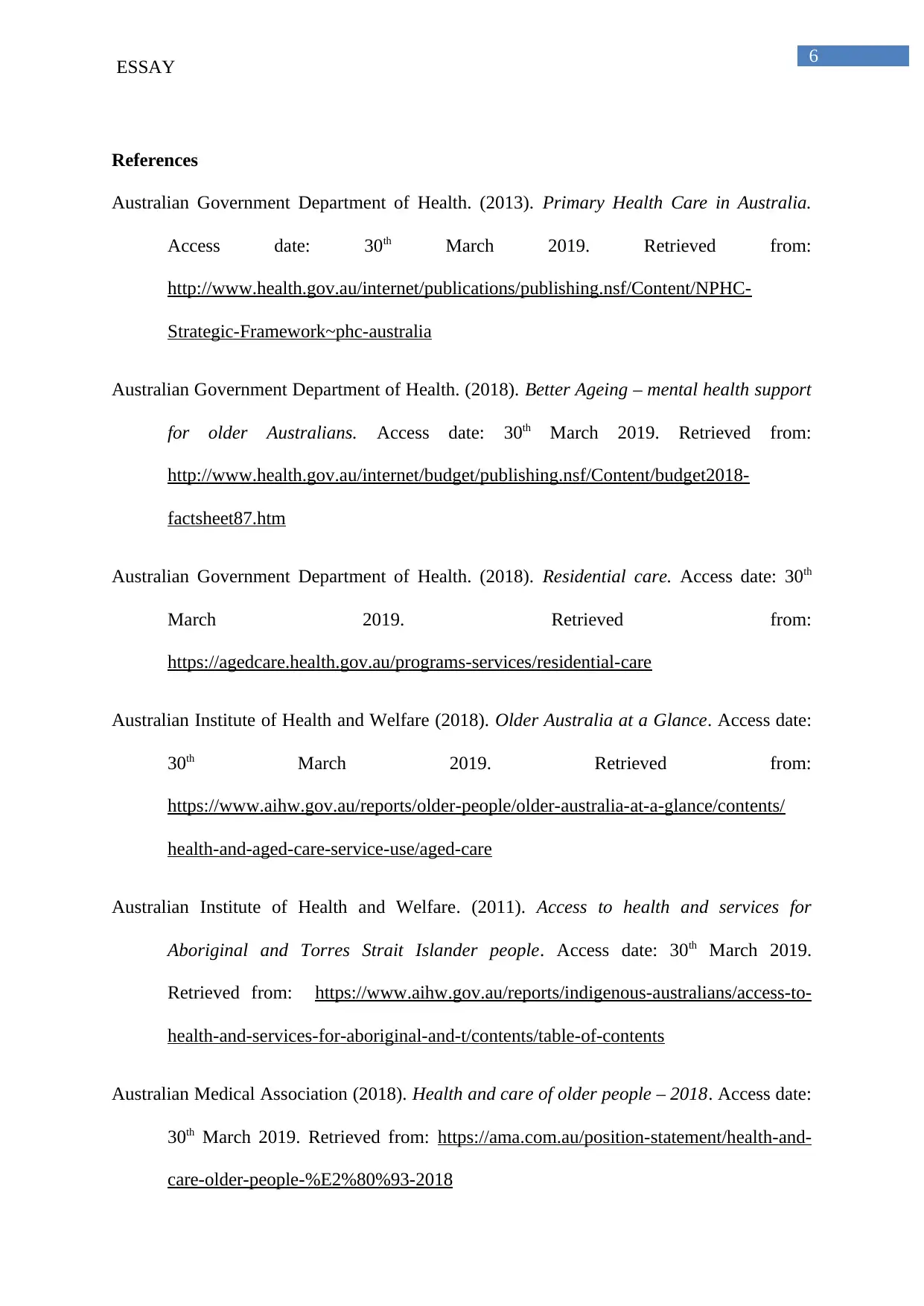
6
ESSAY
References
Australian Government Department of Health. (2013). Primary Health Care in Australia.
Access date: 30th March 2019. Retrieved from:
http://www.health.gov.au/internet/publications/publishing.nsf/Content/NPHC-
Strategic-Framework~phc-australia
Australian Government Department of Health. (2018). Better Ageing – mental health support
for older Australians. Access date: 30th March 2019. Retrieved from:
http://www.health.gov.au/internet/budget/publishing.nsf/Content/budget2018-
factsheet87.htm
Australian Government Department of Health. (2018). Residential care. Access date: 30th
March 2019. Retrieved from:
https://agedcare.health.gov.au/programs-services/residential-care
Australian Institute of Health and Welfare (2018). Older Australia at a Glance. Access date:
30th March 2019. Retrieved from:
https://www.aihw.gov.au/reports/older-people/older-australia-at-a-glance/contents/
health-and-aged-care-service-use/aged-care
Australian Institute of Health and Welfare. (2011). Access to health and services for
Aboriginal and Torres Strait Islander people. Access date: 30th March 2019.
Retrieved from: https://www.aihw.gov.au/reports/indigenous-australians/access-to-
health-and-services-for-aboriginal-and-t/contents/table-of-contents
Australian Medical Association (2018). Health and care of older people – 2018. Access date:
30th March 2019. Retrieved from: https://ama.com.au/position-statement/health-and-
care-older-people-%E2%80%93-2018
ESSAY
References
Australian Government Department of Health. (2013). Primary Health Care in Australia.
Access date: 30th March 2019. Retrieved from:
http://www.health.gov.au/internet/publications/publishing.nsf/Content/NPHC-
Strategic-Framework~phc-australia
Australian Government Department of Health. (2018). Better Ageing – mental health support
for older Australians. Access date: 30th March 2019. Retrieved from:
http://www.health.gov.au/internet/budget/publishing.nsf/Content/budget2018-
factsheet87.htm
Australian Government Department of Health. (2018). Residential care. Access date: 30th
March 2019. Retrieved from:
https://agedcare.health.gov.au/programs-services/residential-care
Australian Institute of Health and Welfare (2018). Older Australia at a Glance. Access date:
30th March 2019. Retrieved from:
https://www.aihw.gov.au/reports/older-people/older-australia-at-a-glance/contents/
health-and-aged-care-service-use/aged-care
Australian Institute of Health and Welfare. (2011). Access to health and services for
Aboriginal and Torres Strait Islander people. Access date: 30th March 2019.
Retrieved from: https://www.aihw.gov.au/reports/indigenous-australians/access-to-
health-and-services-for-aboriginal-and-t/contents/table-of-contents
Australian Medical Association (2018). Health and care of older people – 2018. Access date:
30th March 2019. Retrieved from: https://ama.com.au/position-statement/health-and-
care-older-people-%E2%80%93-2018
Paraphrase This Document
Need a fresh take? Get an instant paraphrase of this document with our AI Paraphraser
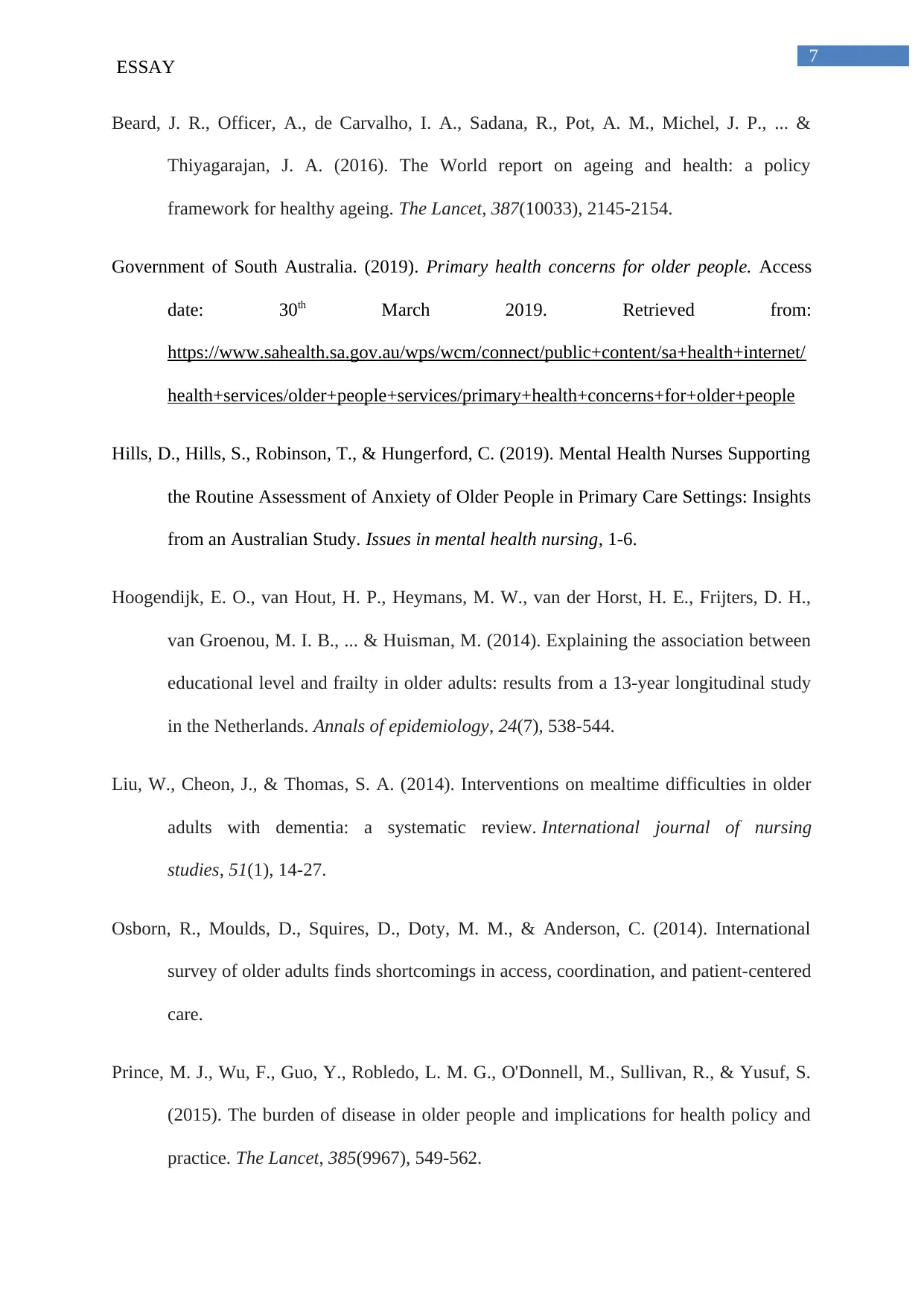
7
ESSAY
Beard, J. R., Officer, A., de Carvalho, I. A., Sadana, R., Pot, A. M., Michel, J. P., ... &
Thiyagarajan, J. A. (2016). The World report on ageing and health: a policy
framework for healthy ageing. The Lancet, 387(10033), 2145-2154.
Government of South Australia. (2019). Primary health concerns for older people. Access
date: 30th March 2019. Retrieved from:
https://www.sahealth.sa.gov.au/wps/wcm/connect/public+content/sa+health+internet/
health+services/older+people+services/primary+health+concerns+for+older+people
Hills, D., Hills, S., Robinson, T., & Hungerford, C. (2019). Mental Health Nurses Supporting
the Routine Assessment of Anxiety of Older People in Primary Care Settings: Insights
from an Australian Study. Issues in mental health nursing, 1-6.
Hoogendijk, E. O., van Hout, H. P., Heymans, M. W., van der Horst, H. E., Frijters, D. H.,
van Groenou, M. I. B., ... & Huisman, M. (2014). Explaining the association between
educational level and frailty in older adults: results from a 13-year longitudinal study
in the Netherlands. Annals of epidemiology, 24(7), 538-544.
Liu, W., Cheon, J., & Thomas, S. A. (2014). Interventions on mealtime difficulties in older
adults with dementia: a systematic review. International journal of nursing
studies, 51(1), 14-27.
Osborn, R., Moulds, D., Squires, D., Doty, M. M., & Anderson, C. (2014). International
survey of older adults finds shortcomings in access, coordination, and patient-centered
care.
Prince, M. J., Wu, F., Guo, Y., Robledo, L. M. G., O'Donnell, M., Sullivan, R., & Yusuf, S.
(2015). The burden of disease in older people and implications for health policy and
practice. The Lancet, 385(9967), 549-562.
ESSAY
Beard, J. R., Officer, A., de Carvalho, I. A., Sadana, R., Pot, A. M., Michel, J. P., ... &
Thiyagarajan, J. A. (2016). The World report on ageing and health: a policy
framework for healthy ageing. The Lancet, 387(10033), 2145-2154.
Government of South Australia. (2019). Primary health concerns for older people. Access
date: 30th March 2019. Retrieved from:
https://www.sahealth.sa.gov.au/wps/wcm/connect/public+content/sa+health+internet/
health+services/older+people+services/primary+health+concerns+for+older+people
Hills, D., Hills, S., Robinson, T., & Hungerford, C. (2019). Mental Health Nurses Supporting
the Routine Assessment of Anxiety of Older People in Primary Care Settings: Insights
from an Australian Study. Issues in mental health nursing, 1-6.
Hoogendijk, E. O., van Hout, H. P., Heymans, M. W., van der Horst, H. E., Frijters, D. H.,
van Groenou, M. I. B., ... & Huisman, M. (2014). Explaining the association between
educational level and frailty in older adults: results from a 13-year longitudinal study
in the Netherlands. Annals of epidemiology, 24(7), 538-544.
Liu, W., Cheon, J., & Thomas, S. A. (2014). Interventions on mealtime difficulties in older
adults with dementia: a systematic review. International journal of nursing
studies, 51(1), 14-27.
Osborn, R., Moulds, D., Squires, D., Doty, M. M., & Anderson, C. (2014). International
survey of older adults finds shortcomings in access, coordination, and patient-centered
care.
Prince, M. J., Wu, F., Guo, Y., Robledo, L. M. G., O'Donnell, M., Sullivan, R., & Yusuf, S.
(2015). The burden of disease in older people and implications for health policy and
practice. The Lancet, 385(9967), 549-562.
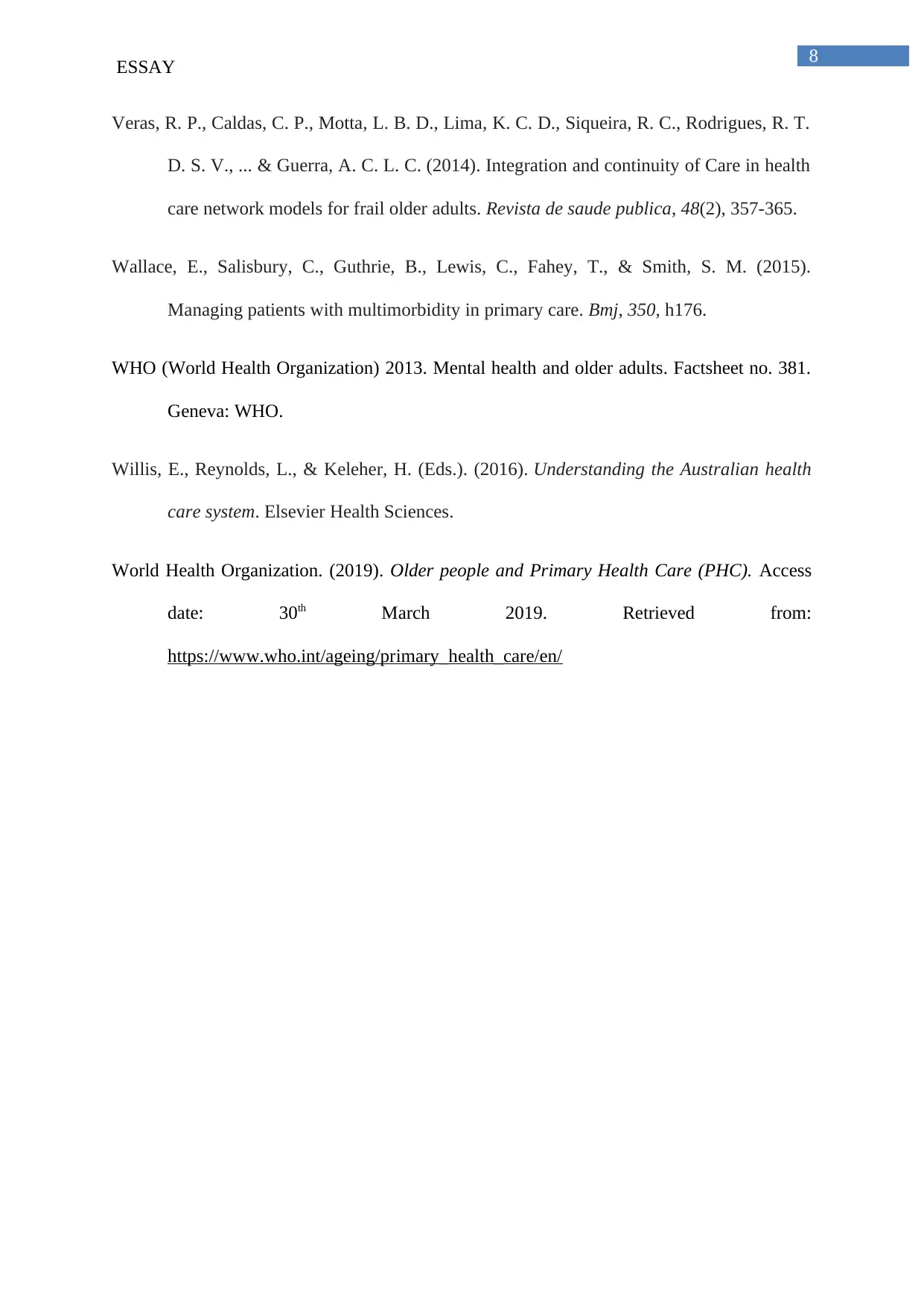
8
ESSAY
Veras, R. P., Caldas, C. P., Motta, L. B. D., Lima, K. C. D., Siqueira, R. C., Rodrigues, R. T.
D. S. V., ... & Guerra, A. C. L. C. (2014). Integration and continuity of Care in health
care network models for frail older adults. Revista de saude publica, 48(2), 357-365.
Wallace, E., Salisbury, C., Guthrie, B., Lewis, C., Fahey, T., & Smith, S. M. (2015).
Managing patients with multimorbidity in primary care. Bmj, 350, h176.
WHO (World Health Organization) 2013. Mental health and older adults. Factsheet no. 381.
Geneva: WHO.
Willis, E., Reynolds, L., & Keleher, H. (Eds.). (2016). Understanding the Australian health
care system. Elsevier Health Sciences.
World Health Organization. (2019). Older people and Primary Health Care (PHC). Access
date: 30th March 2019. Retrieved from:
https://www.who.int/ageing/primary_health_care/en/
ESSAY
Veras, R. P., Caldas, C. P., Motta, L. B. D., Lima, K. C. D., Siqueira, R. C., Rodrigues, R. T.
D. S. V., ... & Guerra, A. C. L. C. (2014). Integration and continuity of Care in health
care network models for frail older adults. Revista de saude publica, 48(2), 357-365.
Wallace, E., Salisbury, C., Guthrie, B., Lewis, C., Fahey, T., & Smith, S. M. (2015).
Managing patients with multimorbidity in primary care. Bmj, 350, h176.
WHO (World Health Organization) 2013. Mental health and older adults. Factsheet no. 381.
Geneva: WHO.
Willis, E., Reynolds, L., & Keleher, H. (Eds.). (2016). Understanding the Australian health
care system. Elsevier Health Sciences.
World Health Organization. (2019). Older people and Primary Health Care (PHC). Access
date: 30th March 2019. Retrieved from:
https://www.who.int/ageing/primary_health_care/en/
⊘ This is a preview!⊘
Do you want full access?
Subscribe today to unlock all pages.

Trusted by 1+ million students worldwide
1 out of 9
Related Documents
Your All-in-One AI-Powered Toolkit for Academic Success.
+13062052269
info@desklib.com
Available 24*7 on WhatsApp / Email
![[object Object]](/_next/static/media/star-bottom.7253800d.svg)
Unlock your academic potential
Copyright © 2020–2025 A2Z Services. All Rights Reserved. Developed and managed by ZUCOL.





